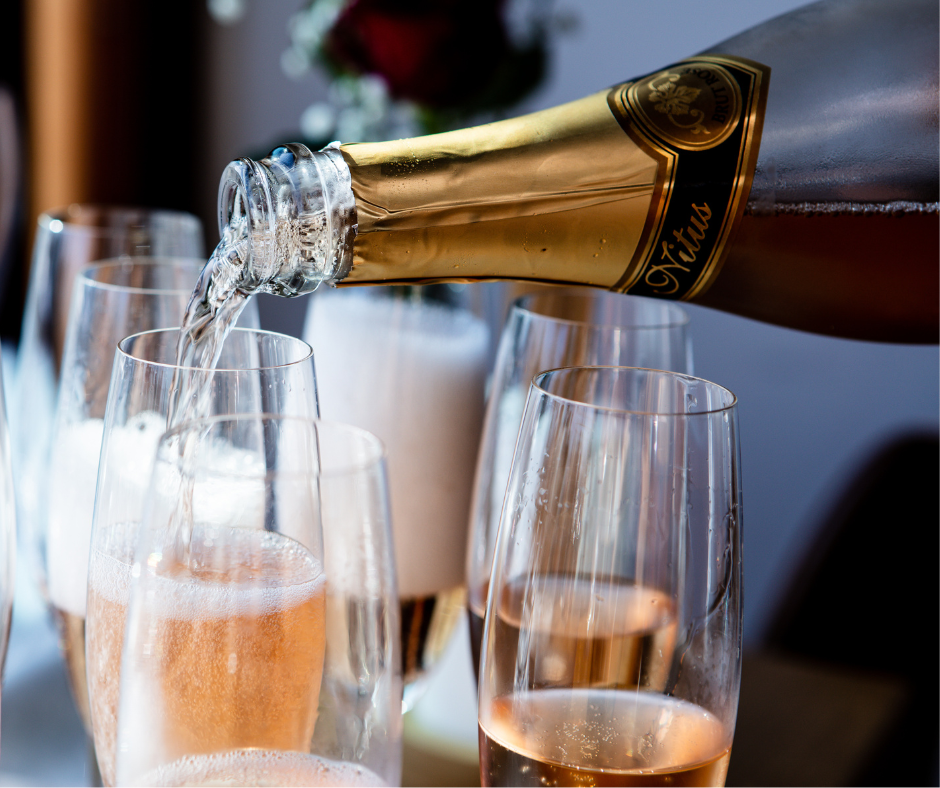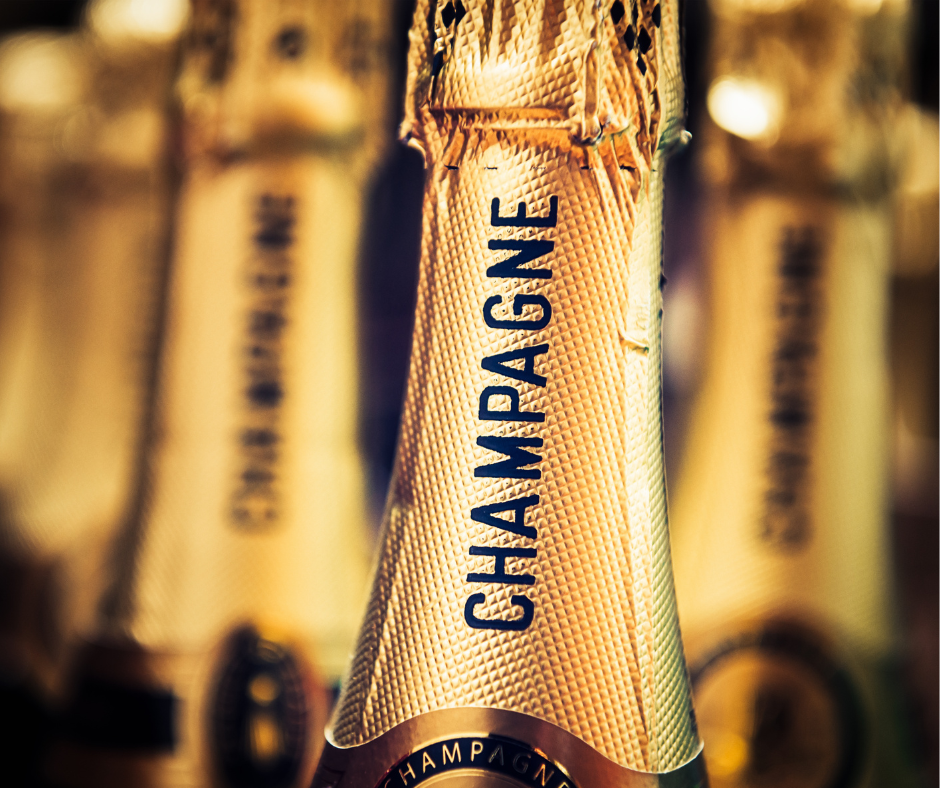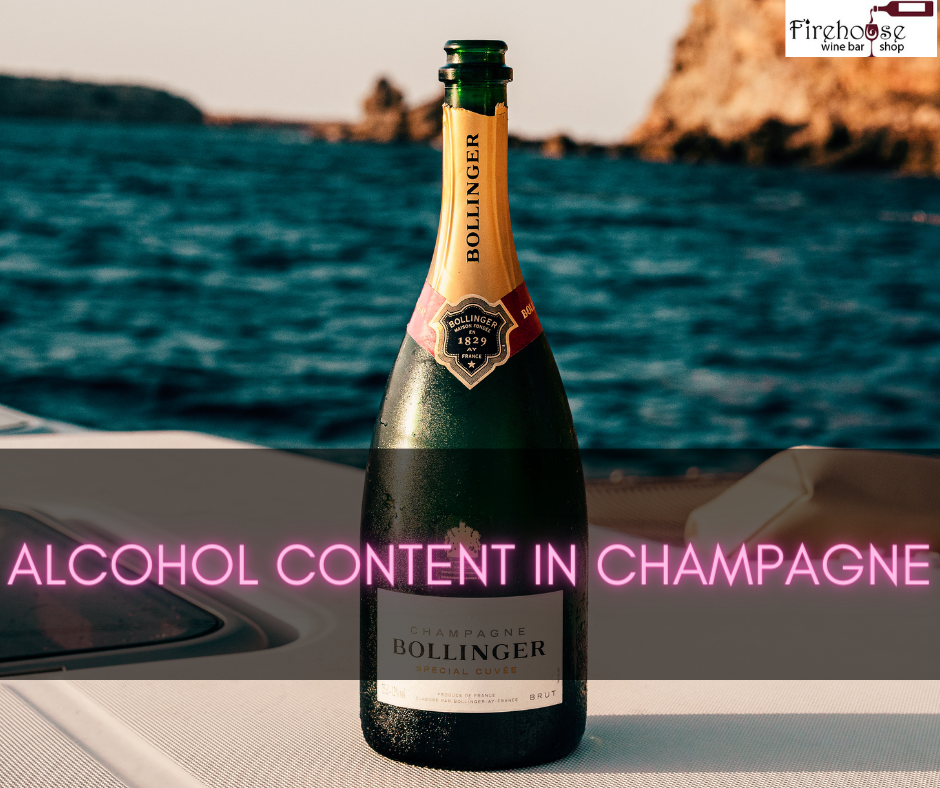Introduction
Champagne is known as the ultimate celebratory drink, but have you ever wondered about its alcohol content? Understanding the alcohol content in champagne is essential for several reasons, and this article aims to shed light on this fascinating aspect of the bubbly beverage.
What Is Champagne?
Before delving into alcohol content, let’s first clarify what champagne is. Champagne is a sparkling wine that originates from the Champagne region in France. It is made from specific grape varieties, including Chardonnay, Pinot Noir, and Pinot Meunier, using a specific winemaking process known as méthode champenoise.
Importance Of Understanding Alcohol Content In Champagne
Knowing the alcohol content in champagne is crucial for a few reasons:
Awareness of Strength: Champagne usually contains an alcohol content between 11.5% and 12.5% ABV (Alcohol by Volume). By being aware of this, you can moderate your consumption and make educated choices regarding your alcohol intake.
Effect on Intoxication: Understanding the alcohol content helps you gauge its effects on your body. Since champagne is often associated with celebrations, it’s important to know how much you consume to avoid overindulgence and potential intoxication.
Pairing with Food: Different champagne styles and alcohol levels complement various foods. For example, a Brut Nature champagne with lower alcohol content pairs well with lighter dishes, while a demi-sec champagne with higher alcohol content can complement richer desserts. Knowing the alcohol content can help enhance your dining experience.
Calorie Considerations: Alcohol content affects the calorie count in champagne. Generally, the higher the alcohol content, the higher the calorie content. Being conscious of this information can assist you in making informed decisions about your diet and lifestyle.
So, the next time you raise a glass of champagne, take a moment to consider its alcohol content. By understanding and respecting the alcohol levels, you can fully enjoy the effervescent experience while making responsible choices. Remember, champagne is all about celebration and creating memorable moments, and being informed about alcohol content contributes to a safe and enjoyable time.

Factors Affecting Alcohol Content In Champagne
Fermentation Process And Alcohol Percentage
The fermentation process determines the alcohol content in champagne. During the initial fermentation, yeast consumes sugar and produces alcohol and carbon dioxide. This process is known as primary fermentation. The alcohol content at this stage is typically around 10-12%. However, champagne undergoes a second fermentation called secondary fermentation, which takes place in the bottle. In this process, a small amount of sugar and yeast is added to create the bubbles. This secondary fermentation can increase the alcohol content by 1-2%.
Variations In Different Champagne Bottles
Alcohol levels also vary depending on the type of champagne you choose. Non-vintage champagnes, which are blends from multiple years, tend to have lower alcohol content compared to vintage champagnes made from grapes harvested in a specific year. Non-vintage champagnes typically have an alcohol content of around 11-12%, while vintage champagnes can reach up to 12.5%.
Other factors that can influence alcohol content in champagne include:
- Grape Varieties: Different grape varieties used in champagne production can contribute to variations in alcohol content. For example, Pinot Noir and Pinot Meunier grapes have higher sugar levels, producing higher alcohol content.
- Ripeness: Grapes harvested at different ripeness levels can affect the sugar levels and, thus, the alcohol content in the final product. Riper grapes have higher sugar content, which translates into higher alcohol levels.
- Winemaking Techniques: The winemaker’s choices and techniques, such as extended maceration or blending of different base wines, can also impact the alcohol content in champagne.
It’s important to note that champagne is typically lower in alcohol than other wine types. The light and delicate nature of champagne makes it a perfect choice for celebrations and toasts without the heaviness typically associated with higher-alcohol wines.
Understanding the factors that affect alcohol content in champagne can help you make informed choices when selecting the perfect bottle for your occasion. Whether you prefer a lighter, more refreshing style or a richer, more complex champagne, knowing the nuances of alcohol content can enhance.
Comparing Alcohol Content In Champagne, Wine, And Beer
When celebrating special occasions or enjoying a glass of bubbly after a long day, champagne is often the drink of choice. But have you ever wondered about the alcohol content in champagne compared to other popular beverages like wine and beer? Let’s take a closer look.
Champagne Vs. Wine: Alcohol Percentage Comparison
Champagne and wine both fall under the umbrella of sparkling beverages, but is there a significant difference in their alcohol content? In general, champagne has a slightly higher alcohol content than most wines. While the alcohol percentage in wine can range from 9% to 16%, champagne typically falls within the range of 11% to 12.5%. This difference in alcohol content is due to the fermentation process and the specific grapes used in each drink.
Champagne Vs. Beer: Alcohol Percentage Comparison
Regarding comparing alcohol content, champagne and beer are quite different. Beer typically has a lower alcohol percentage compared to both champagne and wine. While champagne ranges from 11% to 12.5%, and wine varies from 9% to 16%, the alcohol content in beer generally falls between 4% and 6%. This difference is due to the brewing process, which allows for less alcohol to be produced.
It’s important to note that these percentages are averages and can vary depending on the brand and type of champagne, wine, or beer. Factors such as aging and blending can also impact the alcohol content in these beverages.
Understanding the alcohol content in your drink of choice is vital for responsible consumption. Whether you prefer champagne, wine, or beer, it’s always a good idea to enjoy them in moderation and be aware of the alcohol content to ensure a safe and pleasurable experience.
In conclusion, champagne generally has a slightly higher alcohol content compared to wine, while beer typically has a lower alcohol content than both champagne and wine. Knowing the alcohol percentages of these popular beverages allows you to make informed choices and enjoy them responsibly. So, next time you raise your glass, you can do so with a greater understanding of what’s inside!

Effects Of Carbonation On Alcohol Absorption
When it comes to celebrating, popping a bottle of champagne has become synonymous with festivities and good times. But have you ever wondered about the alcohol content in champagne and how it affects you? Let’s delve into bubbles and booze to understand alcohol absorption in champagne.
How Bubbles Increase Alcohol Absorption In Champagne
Did you know that the carbonation in champagne can accelerate alcohol absorption in your body? The effervescence creates more surface area, allowing the alcohol to be absorbed more rapidly into the bloodstream. This means champagne’s effects can kick in faster than still wines or spirits.
The alcohol content in champagne typically ranges from 11% to 13%, similar to many wines. However, due to the more rapid absorption, it is important to be mindful of your consumption. Drinking champagne too quickly or in large quantities may lead to a higher blood alcohol concentration, potentially leading to intoxication.
Drinking Champagne Responsibly To Avoid Intoxication
Celebrating with champagne can be a delightful experience, provided it is done responsibly. Here are a few tips to help you enjoy your bubbly without risking over-indulgence:
- Pace yourself: Sip your champagne slowly and savor each sip. Take breaks between glasses to allow your body to absorb and metabolize the alcohol.
- Alternate with non-alcoholic beverages: Hydration is key. Drinking water or other non-alcoholic beverages between glasses of champagne can help you stay hydrated and reduce your overall alcohol intake.
- Know your limits: Know your tolerance level and how your body reacts to alcohol. Everyone is different, so listen to your body and drink at a comfortable pace.
- Plan for a safe ride home: If you’re attending a celebration with champagne flowing, have a designated driver or arrange for a ride-sharing service to ensure a safe journey back home.
Remember, champagne is meant to be enjoyed in moderation. So raise your glass, savor the bubbles, and celebrate responsibly!

Understanding Blood Alcohol Content (BAC) And Champagne
Champagne is a popular choice for celebrations and special occasions, but it’s important to understand the alcohol content in this festive beverage. With its effervescence and delightful taste, it’s easy to overlook the potential effects of alcohol. This article will explore how metabolism and body type affect blood alcohol content (BAC) and the implications of drinking champagne and driving.
How do Metabolism And Body Type Affect BAC?
Metabolism and body type play a significant role in determining how alcohol affects our bodies. Metabolism refers to how our bodies break down and eliminate alcohol. Different individuals have varying metabolic rates, influenced by age, weight, gender, and overall health.
When we consume alcohol, it is absorbed into our bloodstream and reaches our brain, impairing judgment, reaction time, and coordination. BAC measures the amount of alcohol in the bloodstream as a percentage. The higher the BAC, the more impaired a person becomes.
People with a higher metabolism tend to process alcohol more quickly, resulting in a lower BAC. On the other hand, those with a slower metabolism may experience higher BAC levels even after consuming smaller amounts of alcohol. Additionally, body type can also impact alcohol absorption. For example, individuals with a higher percentage of body fat may have a higher BAC due to alcohol’s ability to dissolve in fat.
Implications Of Drinking Champagne And Driving
Drinking champagne and driving can have serious consequences. It is crucial to understand the legal limits and guidelines surrounding alcohol consumption and driving in your jurisdiction. Most countries have strict laws regarding driving under the influence (DUI), with severe penalties for those caught exceeding the legal BAC limit.
Even small amounts of alcohol can impair your ability to drive safely. It’s best to designate a sober driver, use public transportation, or arrange for a ride-sharing service if you plan to consume champagne or any other alcoholic beverage. Your safety and the safety of others on the road should always be the top priority.
In conclusion, understanding the alcohol content in champagne and its effects on our bodies is essential. Metabolism and body type can influence how alcohol is processed, leading to different BAC levels. When it comes to drinking champagne and driving, it’s critical to make responsible choices and adhere to the legal limits in your jurisdiction. Celebrate with champagne responsibly and ensure the safety of yourself and others.
FAQ: Bubbles and Booze: Understanding Alcohol Content in Champagne
Q: Why is it important to understand the alcohol content in champagne?
A: Understanding the alcohol content in champagne helps individuals make informed choices when selecting a bottle. It allows them to align their preferences with their desired drinking experience, ensuring they can enjoy champagne responsibly without compromising their health or judgment.
Q: How can I decode champagne labels to determine the alcohol content?
A: Decoding champagne labels is the key to unlocking the information about its alcohol content. By examining factors such as grape varieties, ripeness, fermentation process, blending, and aging, you can gain insights into the specific alcohol content of the champagne you desire to savor.
Q: What are the legal requirements and regulations surrounding champagne labeling?
A: Champagne labeling is subject to specific legal requirements and regulations. These regulations ensure that the labels provide accurate and transparent information to consumers. Familiarize yourself with these guidelines to better understand the alcohol content and other details indicated on champagne labels.
Q: Are there common labels that indicate the alcohol percentage in champagne?
A: Yes, there are common labels that provide information about the alcohol percentage in champagne. By examining these labels, you can easily determine the approximate alcohol content of the bottle you wish to purchase. Examples of common labels and their corresponding alcohol percentages can be explored in our comprehensive guide.
Q: How does the alcohol content in champagne influence its flavors and characteristics?
A: The alcohol content in champagne plays a role in shaping its flavors and characteristics. Higher alcohol content can contribute to a richer and more robust taste, while lower alcohol content results in a lighter and crisper profile. Understanding this relationship can help you select the right bottle that suits your personal preferences.
Q: Is there a recommended approach to enjoying champagne responsibly?
A: Yes, responsible champagne consumption involves pacing oneself, being mindful of personal limits, and appreciating champagne as part of a balanced lifestyle that promotes well-being. By enjoying champagne in moderation, you can fully appreciate its flavors and attributes while maintaining a healthy relationship with alcohol.
Q: Can you recommend any resources for further understanding the alcohol content in champagne?
A: For further understanding of the alcohol content in champagne, you can explore our comprehensive guide titled “Champagne Percentage: Exploring the Alcohol Content of Champagne.” This guide will delve deeper into the subject, providing valuable insights and helping you appreciate the secrets behind champagne’s alcohol content.
Conclusion
Understanding the Alcohol Content in Champagne is essential to celebrate responsibly and enjoy the festivities. By being aware of the alcohol levels, you can make informed choices and pace yourself accordingly. Remember, it’s not just about the bubbles but also the booze!
Celebrate Safely: Tips For Enjoying Champagne Responsibly
- Know your limit: Understand your tolerance for alcohol and drink in moderation. Pace yourself and alternate alcoholic beverages with non-alcoholic ones to stay hydrated.
- Eat before you drink: Having a meal or snacks before drinking champagne can help slow down the absorption of alcohol into the bloodstream.
- Designated driver: Plan for safe transportation if you’re attending a celebration where champagne will be served. Assign a designated driver or use a ride-sharing service to get home safely.
- Watch out for mixing: Champagne cocktails can be delicious but often pack a punch. Be mindful of the added alcohol content when mixing bubbly with other spirits.
- Know the strength: Different types of champagne can have varying alcohol content. Be aware of the strength of the specific brand or type you’re consuming.
Final Thoughts On Alcohol Content In Champagne And Celebrations
As you raise your glass to toast and celebrate special occasions, understanding the alcohol content in champagne allows you to make choices that align with responsible drinking. It’s important to remember that the bubbles in champagne can be deceptive, as they can make you feel less intoxicated than you are.
By being mindful of your alcohol consumption and taking steps to enjoy champagne responsibly, you can fully savor the flavors and experience the joy of celebrations without overindulging. Cheers to a safe and memorable toast!
Note: The information provided in this article is for informational purposes only and should not be considered medical or professional advice. If you have concerns regarding alcohol consumption, please consult with a healthcare professional or alcohol specialist.</small

Andre Lotz immigrated to the United States from South Africa almost 20 years ago. Still, he didn’t feel truly at home until he settled in Mobile—a city that reminds him of his childhood home of Fish Hoek on the southern cape of Africa.

